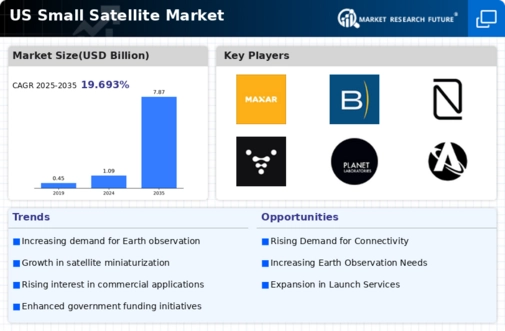Advancements in Launch Services
Advancements in launch services are significantly impacting the small satellite market. The emergence of dedicated small satellite launch vehicles has reduced launch costs and increased accessibility for various stakeholders. In 2025, the average cost of launching a small satellite is projected to decrease by 30%, making it more feasible for startups and research institutions to enter the market. This trend is likely to stimulate innovation and competition within the small satellite market, as more entities seek to capitalize on the advantages offered by these cost-effective launch solutions. Consequently, the small satellite market is poised for robust growth as barriers to entry diminish.
Increased Investment in Space Technology
Investment in space technology is a critical driver for the small satellite market. The U.S. government, alongside private sector players, is allocating substantial funds to develop and deploy small satellite systems. In 2025, the U.S. government is expected to invest over $1 billion in small satellite initiatives, focusing on national security, scientific research, and commercial applications. This influx of capital not only supports the development of innovative technologies but also encourages collaboration between government agencies and private companies. As a result, the small satellite market is likely to witness accelerated growth, with new projects and partnerships emerging to leverage the capabilities of small satellites.
Rising Need for Communication Infrastructure
The small satellite market is experiencing a notable surge in demand for enhanced communication infrastructure. As the need for reliable and high-speed internet connectivity grows, particularly in remote and underserved areas, small satellites are emerging as a viable solution. The Federal Communications Commission (FCC) has been actively promoting initiatives to expand broadband access, which in turn fuels the small satellite market. In 2025, the market is projected to reach approximately $5 billion, driven by the deployment of satellite constellations aimed at providing global internet coverage. This trend indicates a shift towards utilizing small satellites for communication purposes, thereby enhancing the overall capabilities of the small satellite market.
Growing Demand for Data Analytics and Processing
The small satellite market is witnessing a growing demand for data analytics and processing capabilities. As the volume of data generated by small satellites increases, there is a pressing need for advanced analytics to derive actionable insights. Companies specializing in data processing are emerging, providing services that enhance the value of satellite data. In 2025, it is anticipated that the data analytics segment will represent approximately 20% of the small satellite market, driven by industries such as agriculture, urban planning, and disaster management. This trend underscores the importance of integrating data analytics with small satellite operations, thereby enhancing the overall utility of the small satellite market.
Emerging Applications in Agriculture and Environmental Monitoring
The small satellite market is increasingly being driven by emerging applications in agriculture and environmental monitoring. Farmers and agricultural businesses are leveraging satellite data to optimize crop yields and manage resources more efficiently. In 2025, it is estimated that the agricultural sector will account for approximately 15% of the small satellite market, as precision agriculture becomes more prevalent. Additionally, environmental monitoring initiatives, such as tracking deforestation and climate change, are gaining traction. These applications highlight the versatility of small satellites and their potential to address pressing global challenges, thereby propelling the small satellite market forward.























Leave a Comment